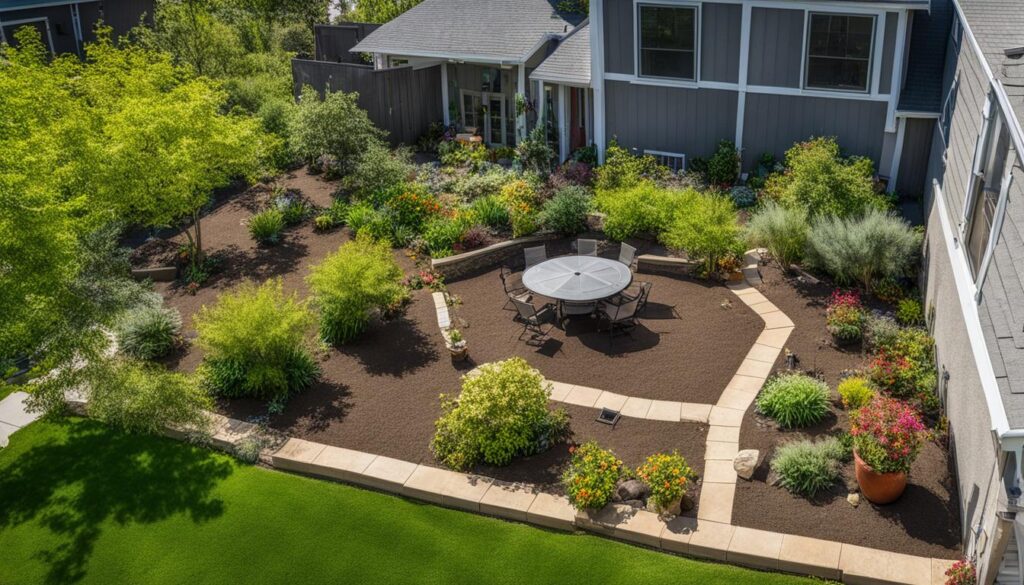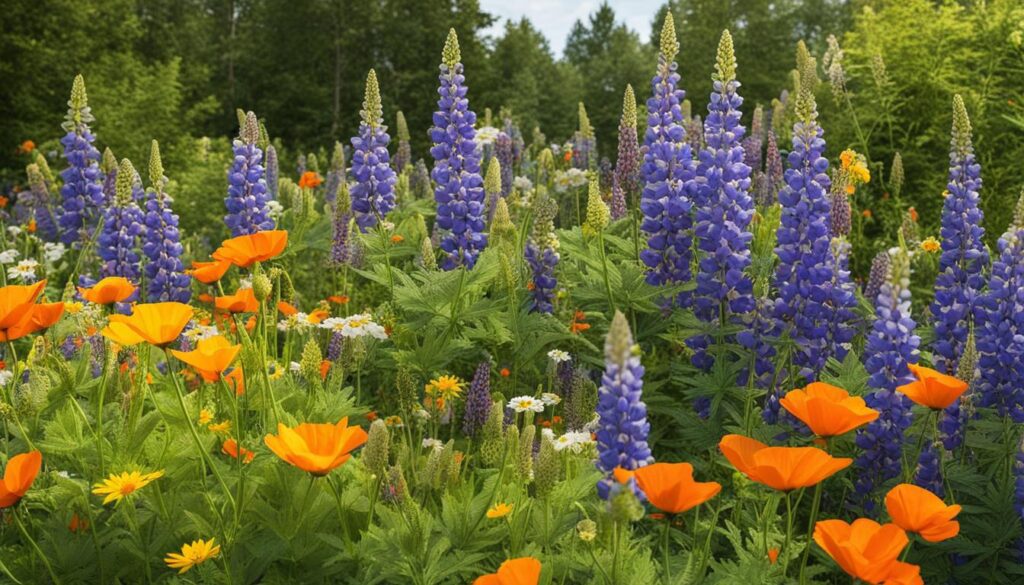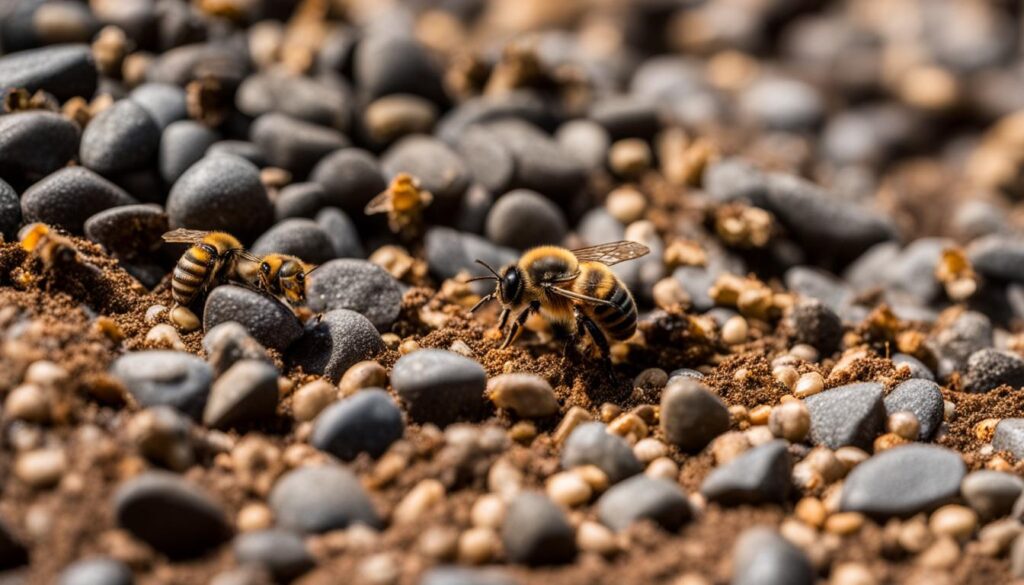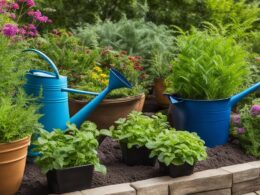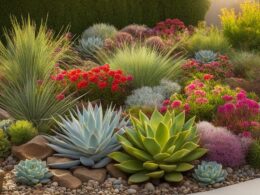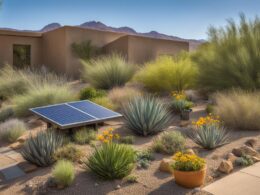Incorporating a xeriscape garden design in your outdoor space can be a beautiful way to conserve water, attract beneficial insects, and enhance the environment. By focusing on creating a sustainable and water-efficient garden, you can also play a vital role in supporting the pollinator population.
Key Takeaways:
- Xeriscape garden design offers a sustainable and water-efficient approach to gardening.
- By attracting beneficial insects, you can promote a healthy and diverse ecosystem.
- Native plants are excellent choices for attracting pollinators due to their adaptation to the local environment.
- Providing habitat and water sources are essential for supporting pollinators.
- Several resources and certifications are available for creating pollinator-friendly landscapes.
Understanding the Importance of Pollinator Gardens
Pollinator gardens play a crucial role in supporting the biodiversity of our ecosystems. Pollinators, such as bees, butterflies, and hummingbirds, are essential for the reproduction of plants. They facilitate the transfer of pollen from the male to female flower parts, enabling plants to produce seeds and fruits. This process is vital for maintaining diverse plant populations and supporting other wildlife species.
“Pollinators are responsible for pollinating more than 75% of the world’s flowering plants, including many crops.”
Pollinators contribute to the overall health and resilience of ecosystems by promoting genetic diversity among plants. This diversity helps plants adapt to changing environmental conditions and increases their chances of survival. In addition to their role in plant reproduction, pollinators also serve as a food source for other wildlife, including birds and mammals. Their presence in a garden can attract a variety of species, creating a thriving and interconnected ecosystem.
Supporting pollinators is essential for:
- Preserving plant diversity
- Ensuring crop production and food security
- Promoting the health of ecosystems
By understanding the importance of pollinator gardens, we can take proactive steps to protect and support these vital creatures. From providing a variety of nectar-rich flowers to creating nesting sites and minimizing pesticide use, every action we take can make a difference in conserving pollinators and the ecosystems they contribute to.
Planning Your Pollinator Garden
When it comes to creating a pollinator garden, careful planning is key. Consider the following factors to ensure your garden is a welcoming haven for pollinators:
- Selecting the Right Location: Choose an area in your yard that receives ample sunlight and has well-draining soil. Most pollinator-friendly plants thrive in full sun, so try to avoid shaded areas. Additionally, consider the proximity to other gardens or natural habitats that may already attract pollinators.
- Opt for Professional Garden Design: If you’re unsure where to start or lack experience in garden design, consulting a professional can be extremely beneficial. A garden designer will consider various factors such as the size and layout of your space, seasonal blooming patterns, and the specific needs of local pollinators.
- Designing the Layout: Carefully plan the layout of your garden to maximize its potential. Consider creating designated areas for different types of plants, such as a meadow section with native wildflowers or a butterfly garden with host plants. Grouping similar plants together can make it easier for pollinators to locate their preferred food sources.
Remember, the success of your pollinator garden depends on careful planning and attention to detail. By selecting the right location, considering professional garden design, and strategically designing the layout, you can create a thriving habitat for pollinators in your own backyard.
Achieve a Beautiful and Productive Garden
When planning your pollinator garden, keep in mind that creating a beautiful and productive garden goes hand in hand with supporting pollinators. Here are a few additional tips to achieve both:
- Choose a Variety of Plants: Opt for a diverse selection of plants that offer different colors, shapes, and blooming periods. This will not only add visual interest to your garden but also provide a continuous source of nectar and pollen for pollinators throughout the season.
- Consider Year-Round Interest: Incorporate plants that provide year-round interest, such as those with attractive foliage or winter berries. This will ensure that your garden remains appealing to both pollinators and human observers all year round.
- Provide Shelter and Water: In addition to nectar and pollen, pollinators also need shelter and water. Include elements such as rocks, logs, or brush piles to provide hiding spots and nesting sites. Consider adding a shallow water source, like a birdbath or small pond, to meet their hydration needs.
By following these guidelines, you can create a pollinator garden that not only supports the ecological well-being of pollinators but also enhances the aesthetic appeal of your outdoor space.
Choosing the Right Plants for Pollinators
When creating a pollinator garden, selecting the right plants is crucial to attract a diverse range of pollinators. Native plants are highly beneficial as they are adapted to the local environment and provide a reliable source of nectar and pollen. Incorporating a variety of flowering plants that bloom throughout the growing season ensures a consistent food source for pollinators.
Consider the size, shape, and color of the flowers when choosing plants for your pollinator garden. Different pollinators are attracted to specific flower characteristics, so incorporating a variety of flower types can help attract a diversity of pollinating insects. For example, hummingbirds are attracted to tubular-shaped flowers, while butterflies are drawn to brightly colored, shallow flowers.
Plant diversity is essential in a pollinator garden as it provides a variety of food sources for different pollinators. Include plants with different heights and structures, such as shrubs, perennials, and grasses, to accommodate the needs of various pollinating insects. By creating a diverse plant community, you can ensure that there is something for every type of pollinator.
Attracting Pollinators: Tips and Tricks
- Include a mix of native plants in your garden to attract region-specific pollinators.
- Choose plants with overlapping bloom times to provide a continuous nectar and pollen source.
- Plant in clusters or drifts to make it easier for pollinators to locate food sources.
- Consider incorporating plants with different flower shapes and colors to attract a variety of pollinators.
- Provide resources like rocks, logs, or nest boxes to offer additional shelter for pollinators.
Remember, creating a pollinator garden is not just about attracting pollinators to your yard — it’s also about providing them with a safe and sustainable habitat. By choosing the right plants, you can create a thriving ecosystem that supports the health and well-being of pollinators and contributes to the overall biodiversity of your surroundings.
Creating Habitat for Pollinators
Creating a habitat that supports pollinators is essential for their survival and the health of our ecosystems. By providing bee nesting sites, water sources, and shelter, you can attract and support a diverse range of pollinators in your garden. Here are some tips to help you create a pollinator-friendly habitat:
1. Bee Nesting:
Bees are important pollinators, and providing nesting sites can encourage them to visit your garden. Leave areas of bare soil or create small mounds where bees can dig their nests. You can also install bee boxes or bee hotels, which provide ready-made homes for solitary bee species.
2. Water Sources:
Having a water source in your garden is crucial for pollinators, especially on hot summer days. Consider placing a shallow birdbath or a small pond with rocks or twigs for insects to land on. Make sure to refresh the water regularly to prevent it from becoming stagnant or a breeding ground for mosquitoes.
3. Providing Shelter:
Pollinators need shelter to rest and protect themselves from predators and extreme weather conditions. Leave dead trees or tree stumps in your garden as potential nesting sites for insects. You can also create brush piles or install insect hotels with hollow stems, bark, or other natural materials that offer shelter to various pollinator species.
4. Preserving Natural Habitats:
Preserving natural habitats around your garden is crucial for pollinators that rely on specific plant species for nesting and forage. Avoid using pesticides, herbicides, or other chemicals that can harm pollinators and their habitats. Instead, embrace a more sustainable approach by planting native flowers, shrubs, and trees that provide food and shelter for pollinators.
By following these tips, you can create a welcoming habitat for pollinators in your garden, supporting their crucial role in our ecosystems.
Resources for Pollinator-Friendly Landscaping
Creating a pollinator-friendly garden is not only beneficial for the environment but also a rewarding endeavor. If you’re looking for resources and certifications to guide you in creating a habitat that supports pollinators, there are several organizations and databases available for you.
Certified Wildlife Habitats
The National Wildlife Federation and the Canadian Wildlife Federation offer guidelines for certifying your garden as a wildlife-friendly habitat. By following their criteria, you can ensure that your garden provides the necessary elements to support pollinators and other wildlife. Registering your garden as a certified wildlife habitat is a great way to showcase your commitment to conservation.
Native Plant Databases
When selecting plants for your pollinator garden, it’s essential to choose native species that are well-adapted to your region. Native plant databases, such as those offered by the North American Native Plant Society and CanPlant, can help you identify suitable native plants for your area. These databases provide detailed information about each plant, including their growth requirements, blooming season, and the benefits they offer to pollinators.
Pollinator-Friendly Certifications
In addition to wildlife habitat certifications, there are various pollinator-friendly certifications available that recognize the efforts put into creating a garden that supports pollinators. These certifications can serve as a badge of honor and provide recognition for your work. The Million Pollinator Garden Movement is one such initiative that encourages individuals to register their gardens and contribute to pollinator conservation efforts on a large scale.
By utilizing these resources and certifications, you can ensure that your pollinator garden is well-planned, contains the right selection of native plants, and meets the standards for supporting pollinators. Take advantage of these tools and make a positive impact on the environment by creating a thriving habitat for pollinators in your own backyard.
Which Xeriscape Plants are Best for Attracting Pollinators to my Garden?
When selecting native xeriscape plants for a pollinator-friendly garden, consider options like lavender, yarrow, and salvia. These plants are not only low-maintenance and drought-tolerant but also attract bees, butterflies, and other important pollinators to your garden, helping to support local ecosystems.
Conclusion
Creating a xeriscape garden design for pollinators is a rewarding and environmentally beneficial endeavor. By conserving water, attracting beneficial insects, and enhancing your environment with native plants, you can contribute to the conservation of pollinators and support the overall health of ecosystems.
Start planning your pollinator-friendly garden today and make a positive impact on the planet. By carefully selecting plants that provide food and habitat for pollinators, you can create a vibrant and biodiverse garden. Consider consulting with a professional garden designer to optimize the layout and ensure the success of your pollinator garden.
Remember to incorporate a variety of flowering plants that bloom throughout the growing season to ensure a consistent food source for pollinators. Native plants, in particular, are highly beneficial as they are adapted to the local environment and provide a reliable source of nectar and pollen.
With your efforts, you can play a vital role in supporting the pollinator population and preserving the delicate balance of our ecosystems. So, roll up your sleeves, put your green thumb to work, and create a beautiful and pollinator-friendly garden in your own backyard.







